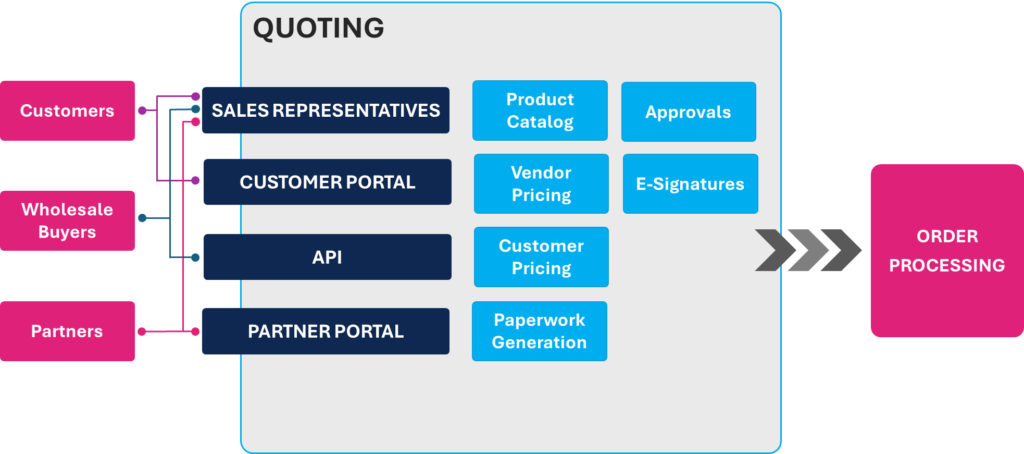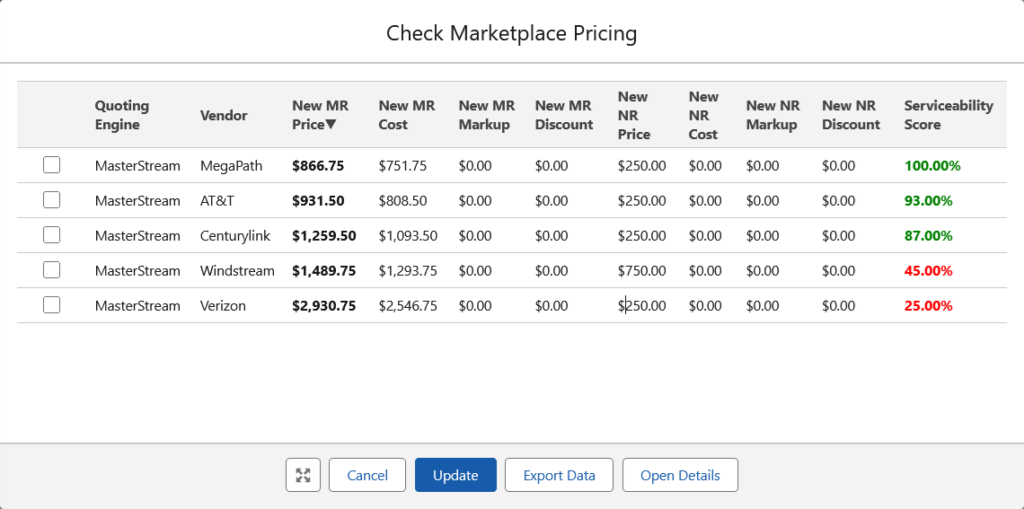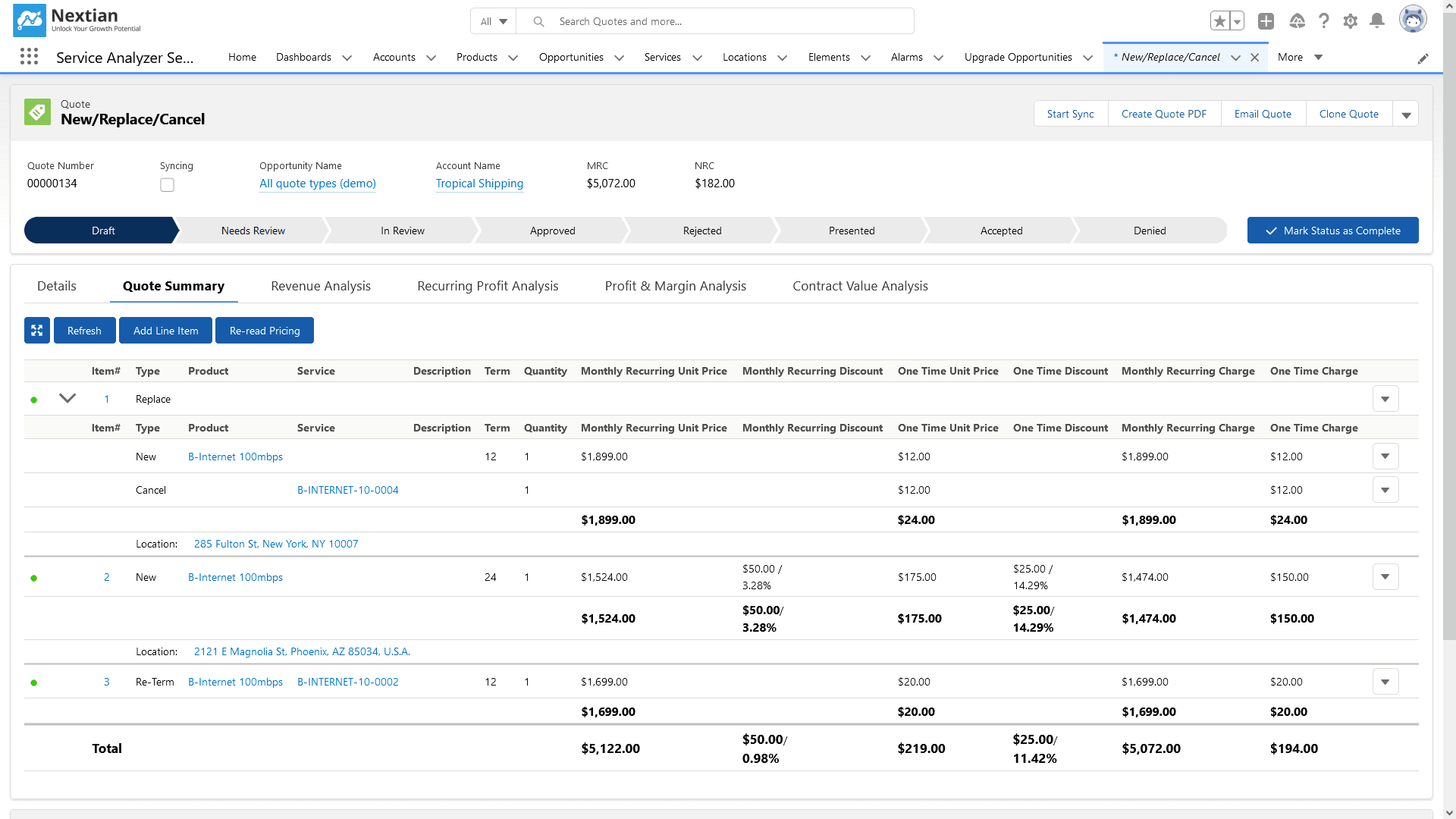Quoting Telecommunications Services — Challenges, Considerations and Implementation Guidelines
Quoting telecommunications services is more complex than traditional subscription service quoting. The primary factors contributing to complexity include:
- Reselling services sourced from other providers,
- Variable product pricing dependent on vendor, location, and technology,
- Quoting service changes (MACDs),
- Handling both end-customer and wholesale sales,
- High volumes of sales made by agents (resellers).
Due to these factors, traditional CPQ (Configure, Price, Quote) solutions that work well in other industries often fall short for telecommunications providers. Also, quoting communications services typically involves multiple systems rather than a single CPQ package: a quote request might come in as a ticket, pricing might be obtained from one system, and paperwork might be prepared in another.
Therefore, providers must carefully design their CPQ architectures to address these unique challenges effectively.
This post highlights the differences between traditional and telecommunications quoting and provides best-practice implementation guidelines.
Buyer Types
Communications providers receive quote requests from various parties, including:
- End-customers: businesses or residential customers purchasing directly from the provider.
- Wholesale buyers: other providers that are buying services at wholesale prices to sell them to their end-customers.
- Reseller partners (a.k.a. Agents or Telecom Service Brokers — TSBs): selling services to end-customers on behalf of the provider for a sales commission. Partners typically do not participate in wholesale.
While direct customers and wholesalers can be managed using different price books (e.g., retail and wholesale), handling partner commissions and SPIFFs is usually more complicated.
Quoting Channels
In addition to having various types of buyers, providers often receive quotes through multiple channels, including:
- Email and Quote Desk: Sales representatives respond to quote requests going through the full CPQ cycle: configuring products and locations, pricing items, paperwork generation, approvals and requesting customer signatures.
- APIs: APIs are primarily used for pricing new services on a subset of products, such as access. These transactions are characterized by high volumes and low win rates. Ordering may be automated or handled manually by sending the quote number to a sales representative, who then creates the paperwork and obtains signatures.
- Customer Portals allowing customers to purchase new products as well as make changes to their existing services. This can range from submitting a quote desk request to a fully automated process.
- Partner Portals enabling partners to create quotes for their end-customers, typically with the full CPQ cycle including paperwork generation and customer signature.
Ensuring quoting consistency and smooth quote-to-order transitions across all these channels can be challenging. Fortunately, providers typically focus on a subset of these channels to limit complexity. Additionally, not all channels may be equally important to every provider. For example, a provider with no wholesale business will likely not prioritize APIs, while a wholesale-only provider will not build a complex customer portal.

Obtaining Pricing
As mentioned earlier, pricing for telecommunications services is far more complicated than merely selecting a price book, product and term. It involves several additional factors, including:
- Additional quoting parameters (a.k.a., dimensions) such bandwidth, service locations, transport types and others.
- Dynamic pricing based on on-net/off-net locations, vendors, vendor products, building lit status and others.
- Product matching of provider’s own products with third-party offerings.
- Pricing rules for calculating end-customer pricing based on vendor costs, markup and other rules.
This necessitates a need for comprehensive pricing engines rather than static price books.
Performance is a critical aspect to consider; searching through multiple systems or extensive databases can be time-consuming (taking up to several minutes) compared to straightforward product lookups, and this can significantly influence system design.

Automated vs. Manual Quotes
In some cases, pricing cannot be obtained automatically. For example:
- A location may not have fixed access, but wireless access can be proposed instead.
- A local provider needs to be contacted to obtain a quote.
- The end customer requires special pricing.
A manual or exception quote path must be available for these scenarios. Fortunately, it is unlikely to be necessary for API-requested quotes.
Quoting Service Changes / MACDs
MACDs add significant complexity to the quoting process. They require an accurate inventory of current services and a well-defined change catalog. Also, service inventory is often not built into quoting engines, necessitating additional integrations. As a result, providers usually focus on quoting new services leaving MACDs as a somewhat manual (and often not very well defined) process.
Both Nextian CPQ and Nextian Customer Portal support MACDs by leveraging a common service inventory and relying on external pricing / quoting engines for third-party pricing.

Converting Quotes to Orders
Transforming quotes into orders is a critical step in the quote-to-cash cycle. Ideally, this process should be fully automated to eliminate the need for manual data re-entry, reduce errors, and cut labor costs as well as ensuring that no orders are missed.
Successful automation requires uniformity in how quotes are converted into orders, regardless of their origin or type. For example, a new service order originating from the Customer Portal should transition into order management and service delivery as seamlessly as a service modification or disconnect request.
Implementation Guidelines
Designing a “one size fits all” quoting architecture for all types of communications providers is challenging. As mentioned earlier, a wholesaler will have different priorities than a provider focused on enterprise sales or one working predominantly with agents.
However, there are common steps that can be taken regardless of specifics:
- Outline a step-by-step process for each each supported buyer and quote origination channel that should be supported by the business (“future state”).
- Ensure that special cases and exceptions (specific service terms, manually selected vendors, vendor pricing requests that cannot be automated) are included in the process.
- Identify fundamental, required functionalities (similar to software micro-services) like product catalog, obtaining third party costs, calculating end-customer pricing, paperwork generation, approvals and others.
- The functionalities above will usually be spread across multiple IT systems. Map functionalities to systems as follows:
- Ensure that each functionality is implemented by a single system (i.e., one functionality, one system). For example, if multiple product catalogs are used, consolidate them.
- Minimize the total number of systems (one functionality, one system, but one system can handle many functionalities) to reduce the number of integration points.
- Consider what types of business reports are required and determine where the information resides.
- Ensure a single quote-to-order conversion point.
- Compare future state to the current state and create a transformation roadmap / plan.
Conclusions
Quoting telecommunications services is inherently more complex than traditional subscription service quoting due to additional parameters (vendor, location, technology, etc.), variable third-party pricing and service changes (MACDs). It often involves multiple IT systems: a quote request might originate as a ticket, pricing might be obtained from one system, and paperwork prepared in another.
As a result, traditional CPQ (Configure, Price, Quote) packages are often not well-suited for cloud and communications services. While no universal solution exists for all providers and service types, following the steps outlined above can help identify the right quoting architecture to enable a uniform quote-to-order process, regardless of quote origination or type.
Nextian has extensive experience implementing and optimizing quoting systems for cloud and communications providers, both in Salesforce and on other platforms, to drive business growth and sales velocity.
Contact us today to find out how we can help with your quoting & CPQ challenges!





